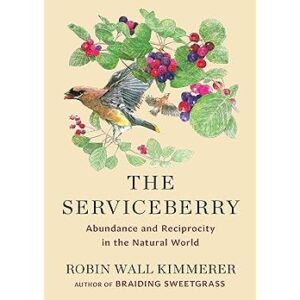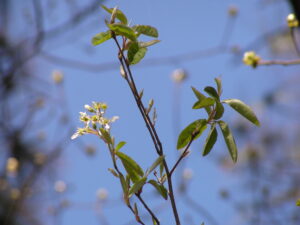
By Mary Reid Barrow
Our legendary shadbush, so named because the small tree blooms when shad run upstream to spawn in spring, is the centerpiece of a beautiful little book that’s number two on the New York Times nonfiction best seller list!
Author Robin Wall Kimmerer compares nature’s gift economy and our financial economy in “The Serviceberry, Abundance and Reciprocity in the Natural World”.
The shadbush is more commonly call serviceberry in other parts of the south, because it blooms in early spring when mountain roads have thawed, and residents can make it to church services.
The beautifully illustrated book focuses on the free gifts of the serviceberry, or shadbush, compared to the buying and selling economy of the financial world.

Serviceberry gifts include pretty white flowers in spring that nurture insects and birds, bright red berries in summer that birds and people love and brilliant leaves in autumn that fall to the ground and nurture the soil.
Can you imagine a holiday gift more appropriate for native plant lovers than a holiday gift bundle that includes a copy of “The Serviceberry,” a good sized serviceberry tree ready to plant and a $20 gift certificate. It’s available for $100 at Southern Branch Nursery in Chesapeake that specializes in native plants. Find out more here.
A hummingbird began hanging around my neighbor Jenny Johnson’s house a few days ago. She named the little one Elsa and sent this photo taken from afar.
Jenny had taken her hummingbird feeder in for the winter when she saw Elsa looking for the missing feeder. She quickly hung it back up and now sees the little bird most days and recently, yet another turned up. She took this photo from afar.

It’s hard to know if they are late migrators caught by the cold or if they didn’t have the strength or inclination to fly any farther.
Years ago when I arrived home from Christmas vacation, I found a little hummer at the dirty feeder that I had forgotten to take down before I left!
I fed her through the winter, getting up at dawn on very cold nights to change the frozen feeder out. Hummers take shelter in dense shrubbery on cold nights. They also go into a state of torpor where their bodily functions slow down, but they must have a meal to fuel those active little bodies when the sun rises
I was so relieved when my little bird made it until spring.
On the other hand, it’s not a hobby I’d recommend. It’s surprising how something so tiny can make you feel so responsible!
Unlike the little hummer, yellow-bellied sapsuckers arrive here to spend the winter on purpose. After last week’s Nature Notes on Reese Lukei’s wintering sapsucker, Stuart McCausland said he had taken a video of two of the interesting little woodpeckers in his yard.
The birds get their name from the sap wells they drill around trees in order to “suck” the sap to dine.
Here’s Stuart’s video of the birds as they appear to search for the ideal place to begin drilling: